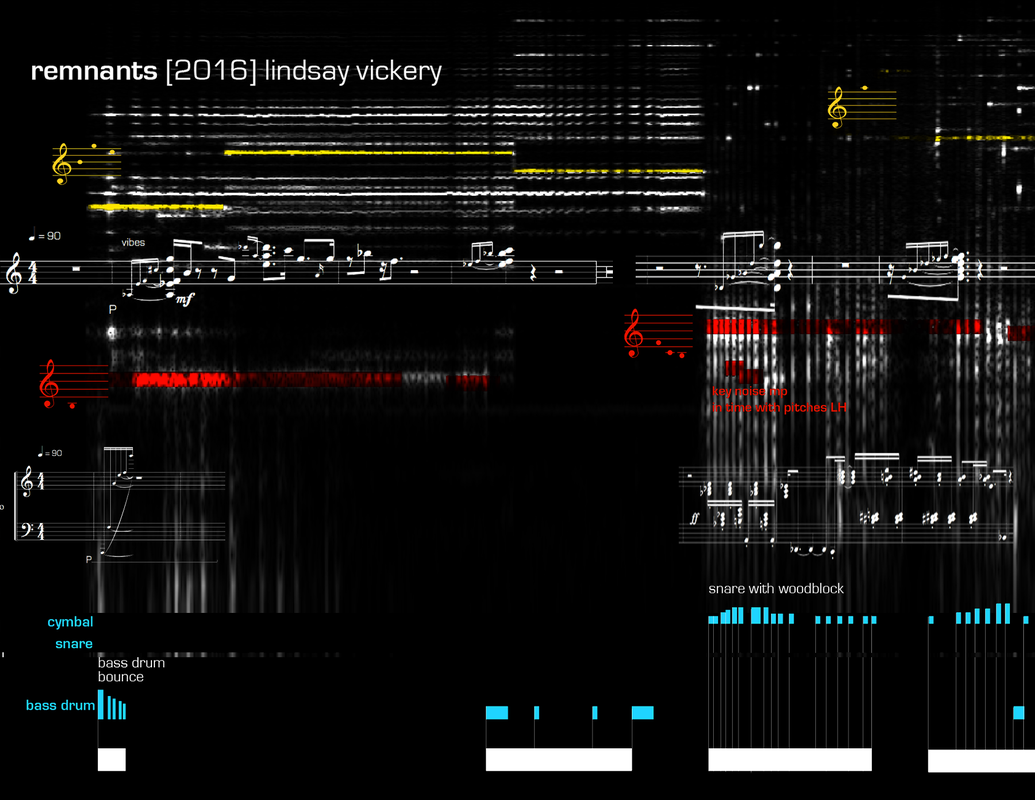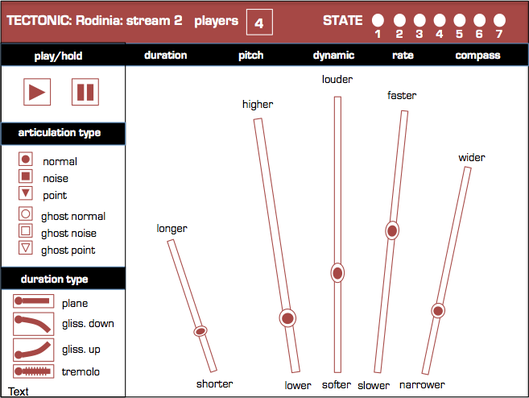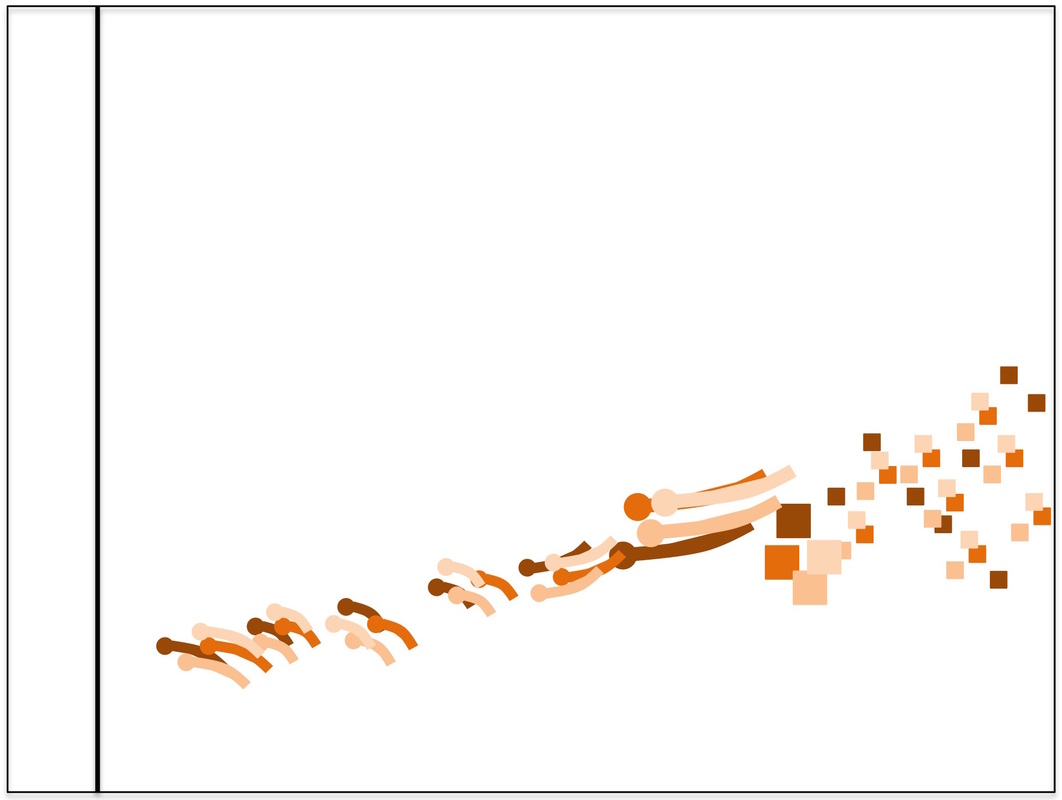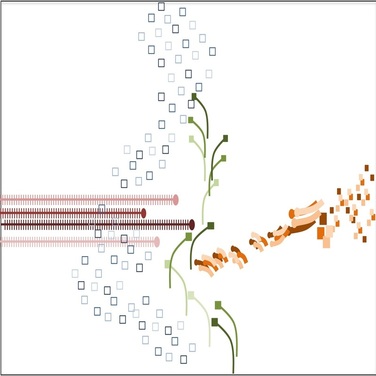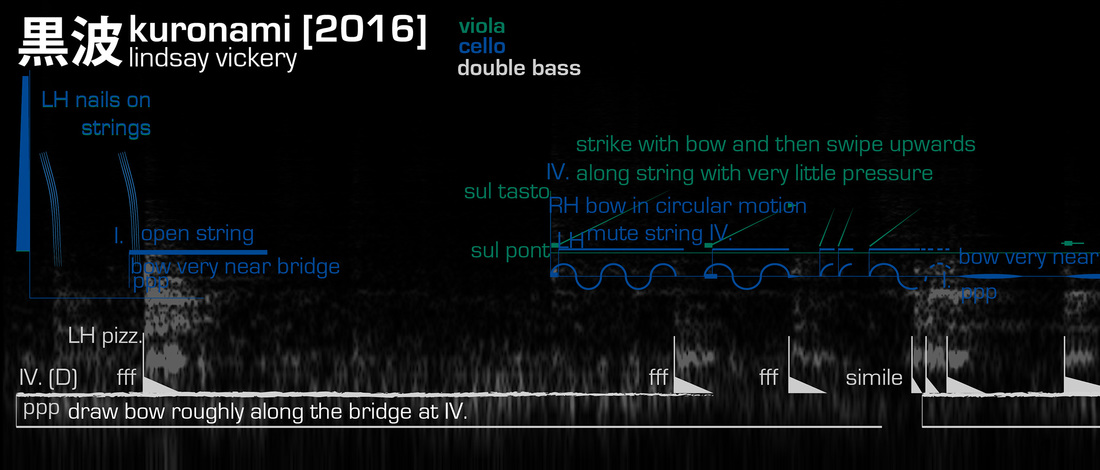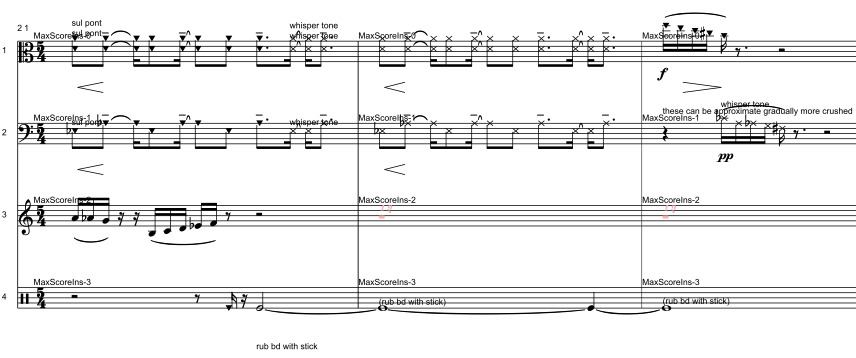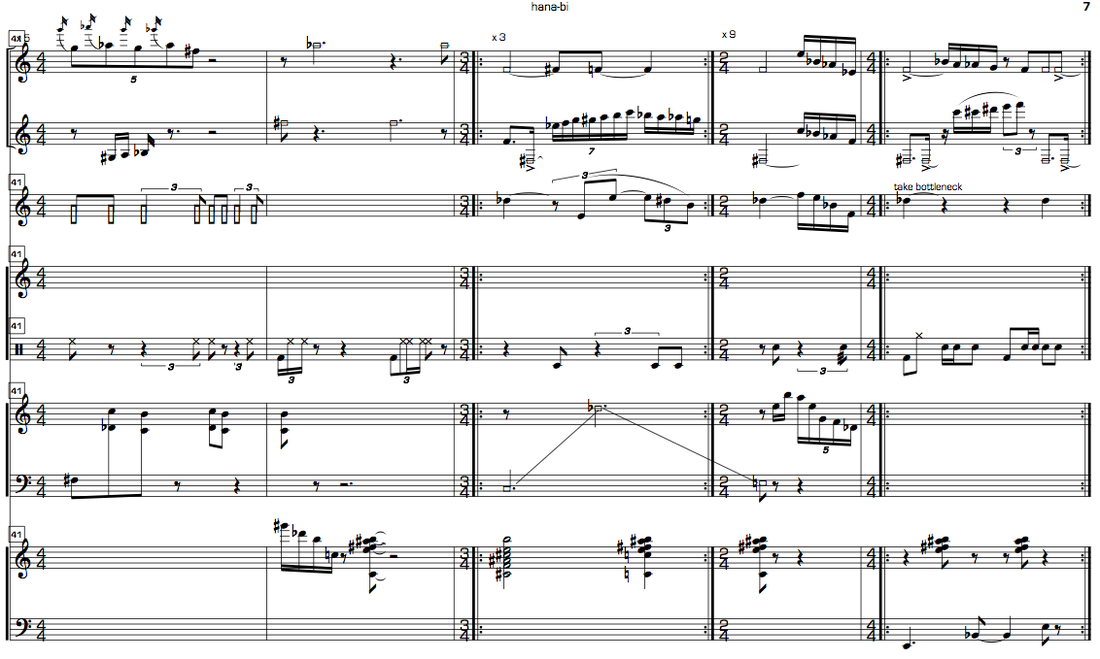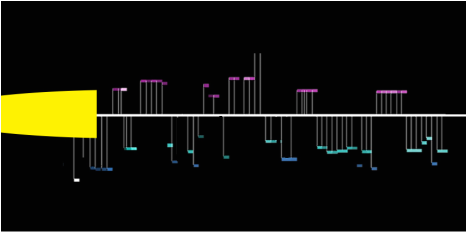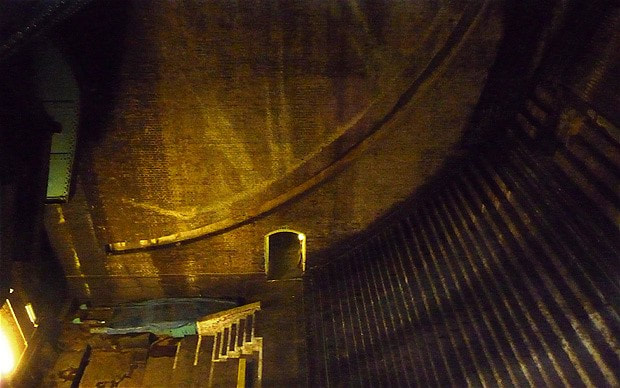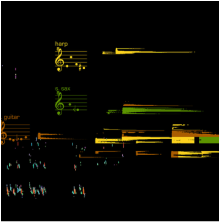2016
168 remnants (version 1) [2016] for solo piano, flute, bass clarinet, 2 percussion and fixed media.
remnants (version 2) [2016] for disklavier, flute, bass clarinet, violin, cello, percussion and fixed media.
|
remnants was composed for virtuoso pianist Zubin Kanga and combines a traditionally notated music solo piano score with annotated, proportionally notated graphic scores for the accompanying ensemble. Like earlier works such as residual drift and detritus, the work is the result of a preoccupation with the “off-space” by-products of the composition process: a consideration of materials at the edge. remnants is a transcription of an improvisation for bass clarinet and electronics based on analysis of its spectral components. The original ephemeral materials were reworked into a fixed notated score.The transcription aimed at clarification, categorisation and annotation of the found sounds rather than intervention or arrangement. Specialised software was developed to transcribe sounds of an audio file into piano notation music notation in an “instrumental resynthesis”. In the second version of the work, the original solo piano and vibraphone parts are replaced by a disklavier“ performing” a MIDI transcription of the spectral data created by software I created earlier this year. The score was also reorchestrated to include the full Decibel ensemble with violin and cello.
Performances:
20161125 Simon Emmerson and Decibel, WAAPA Music Auditorium. (version 2) 20161104 Decibel DAAD Residency, MS Stubnitz, Hamburg. 20161005 Zubin Kanga and Decibel. Sound Spectrum 2016.2 Festival, 5 Oct 2016,WAAPA Music Auditorium. (version 1) 20201205 WAAPA Ultra Marathon Spectrum project space (version 3) |
|
167 TECTONIC: Rodinia [2016] for four iPad conductors and four ensembles.
TECTONIC: Rodinia is a work for four realtime composer-conductors and four ensembles. In geology Rodinia is the name of a supercontinent that contained most of Earth's landmass between 1.1 billion and 750 million years ago. Tectonic can mean both ‘the study of the earth's structural features’ and ‘the art of construction’ and this works reflects both aspects of the word’s meaning. The concept of slowly shifting plates that crush and reform each other’s placement is the central paradigm of the work. Rodinia is the second in a series that began with Tectonic: Vaalbara [2008]. In Vaalbara five instrumental streams are performed independently, using computer generated metronome pulses to manipulate the tempo of each stream, allowing the blocks of musical material to slide, grate and collide with one another like tectonic plates.
|
|
In Rodinia four composer/conductors control separate streams of graphical notation and audio (comprising live instruments reading the notation and their processed audio components) that interact through the algorithmically evaluated Mass and proximity of each stream. The work is performed using the Decibel Scoreplayer on multiple iPads via a manually connected network allowing for each participant conductor or performer to identify independently on the network [1]. The manually connected network was first used in Laura Lowthers’ work for the Decibel ensemble, Loaded [2015]. Previous scores had prioritized synchronization between multiple iPads in order to present uniform representation of fixed scores for all performers. It is made possible by the adoption of the bonjour protocol protocol to manage connectivity over the network. The use of the bonjour protocol also allows connectivity via OSC to stream data to other devices. In Rodinia this is used to stream generative data to a dedicated computer using Wave Terrain synthesis to process and spatialise the audio from the ensemble.
The graphical symbols displayed on a large screen to the audience are rendered as semantic spatial notation for the performers in which pitch is rendered as vertical height, duration as horizontal length, dynamic as the width of the event, timbre as shade etc. The notation for the four instrumental groups is rendered in four opposing directions for the audience (i.e. Left to Right, Right to Left, Up to Down and Down to Up), but from right to left for the performers (See below).
Performances:
20161112 Decibel DAAD Residency Exchange Hamburg, Hochschule für Theater und Musik . 20170407 7 April 730 - Sonic Wonderment Revisited - WAAPA Auditorium |
166 kuroinami 黒波 [2016] for biwa, viola, cello, double bass and fixed media
|
A response to the 2011 Tōhoku Tsunami: the black ocean enveloping Sendai Airport. The work employs a spectral tracing of an electronically treated recording of a bass drum by string instruments employing extend techniques. The work kuroinami 黒波 (black wave) was in planning since noise duo Candied Limbs tour of Japan in 2011, but only crystalized in 2016 with the creation of the source audio and development of transcription techniques.
Performances:
20160813 Decibel: Sound Unbound: Music from Visitors, Spectrum Performance Space. 20161210 Decibel: Chance Figuration, Tokyo Wonder Site, Hongo. |
165 abstract clouds of the western skies [2016] for viola, cello, percussion and electronics.
|
A nonlinear work in which a 68 measure "source score" is deconstructed into passages and single measures to create a texture that alternates indeterminate juxtapositions with more synchronous linear "composed" passages. Abstract Clouds is the second work in this formal framework (the first was Improbable Games [2010]). The title of the work is from the proto-surrealist poetry of André Breton and Phillipe Soupault’s The Magnetic Fields [1919]. The work is written for Georg Hajdu's MaxScore and was created as part of a Universities Australia and the German Academic Exchange Service (DAAD) residency between staff from Hochschule für Musik und Theater, Hamburg and WAAPA at Edith Cowan University.
Performances:
20170323 Sound Unbound Music From Visitors, Spectrum Project Space, ECU Mt Lawley 20160729 Decibel: Sound Unbound: Music From Visitors, Spectrum Project Space, ECU Mt Lawley |
|
164 tomorrow god only never knows [2016] for vibraphone, piano and fixed media
|
The Beatles' Tomorrow Never Knows and The Beach Boys' God Only Knows in the blender (and thresher and reanimator etc) to celebrate the 50th anniversary of their release.
|
|
163 Tokyo Avian Sound Ark 東京鳥音箱舟 [2016] clarinet, electric guitar, harp and fixed media
|
Tokyo Avian Sound Ark [2016] continues composer Lindsay Vickery's exploration of "field recordings" as a musical source material. In this work a recording of the sonic environment outside Tokyo was processed electronically to create a polyrhythmic web of sound that strangely echoed the Sen no Ongaku (linear music) style explored by Jo Kondo in the 1970s. In recent times Vickery has developed processes for transcribing sound into scores that draw out prominent auditory events and notate them, allowing live performers to engage ephemeral and complex sounds in a precise manner. In Tokyo Avian Sound Ark, clarinet, harp and electric guitar highlight the ever-changing cross-rhythms of the electronic part to create a hybrid work part, field recording, part electronic work and part chamber music.
Performances:
20160420 GreyWing: Tokyo Sound Space Ark, WAAPA, Perth 20161213 Decibel: iCLA Yamanashi University, Japan 20161215 Decibel: Chance Figuration Collaborations. Kunitachi College of Music 20161216 Decibel: Tokyo Metropolitain University |
|
161 nature forms II [2016] for flute, clarinet, viola, cello, percussion and hybrid field recording
|
20160305 Nature Forms: lindsay vickery and ANU New Music Ensemble, collected resonances, ANU Canberra.
20160513 GreyWing: nature forms , State Library of WA 20160525 Tenor 2016, Anglia Ruskin University, Cambridge, UK. 20160710 Sonic Environments: Australasian Computer Music Conference 2016, Griffith University, Brisbane. Blog
20151128 |
Nature Forms II is an eco-structuralist work, maintaining what Opie and Brown ( term the “primary rules” of “environmentally-based musical composition”: that “structures must be derived from natural sound sources” and that “structural data must remain in series”. Nature Forms II explores the possibility of recursive re-interrogation of a field recording through visualization and resonification/resynthesis via machine and performative means. The source field recording is contrasted with artificially generated versions created with additive, subtractive and ring modulation resynthesis.
Interaction between the live performers and the electronic components are explores through “spectral freezing” of components of the field recording to create spectrally derived chords from features of the recording bird sounds and a rusty gate which are then transcribed into notation for the instrumentalists and temporal manipulation of the recording to allow complex bird calls to be emulated in a human time-scale. |
160 bascule [2016] for ensemble
|
Performances:
20160305 Nature Forms: lindsay vickery and ANU New Music Ensemble, collected resonances, Canberra |
The work is an orchestration of an extraordinary recording made by Ian Rawes of The London Sound Survey. The original recording, "Bascule Chamber: North", was released on the London Sound Survey album "Thames" (Persistence of Sound). The bascule itself is a large chamber below London's Tower Bridge built to allow for the movement of counterweights used to lift the drawbridge. In this highly resonant space, the machinery produces a spectacular "sound-mass"-like structure of vast engines, cables and winches. The recording was "spectrally orchestrated" for a chamber orchestra of winds, brass, percussion and strings.
|
159 small waves raised by the evening [2016] for bass clarinet, electric guitar, harp and fixed media
THIS IS A delicious evening, when the whole body is one sense, and imbibes delight through every pore. I go and come with a strange liberty in Nature, a part of herself. As I walk along the stony shore of the pond in my shirt-sleeves, though it is cool as well as cloudy and windy, and I see nothing special to attract me, all the elements are unusually congenial to me. The bullfrogs trump to usher in the night, and the note of the whip-poor-will is borne on the rippling wind from over the water. Sympathy with the fluttering alder and poplar leaves almost takes away my breath; yet, like the lake, my serenity is rippled but not ruffled. These small waves raised by the evening wind are as remote from storm as the smooth reflecting surface. small waves uses the contours of a field recording as its formal structure. different aspects of the recording are highlighted via a range of digital processes and transcribed for bass clarinet, electric guitar and harp. The title is a quote from Henry David Thoreau's Walden - part of an extended reflection on the sounds of nature - birds, frogs, leaves and the night wind - from the chapter Solitude. The field recording was made by Philip Kenworthy.
|
|
Performances:
20160301 GreyWing Western Australian Academy of Performing Arts, Perth 20160305 Nature Forms: lindsay vickery and ANU New Music Ensemble, collected resonances, ANU Canberra. 20160513 GreyWing nature forms , State Library of WA |
|

